CHCECE010: A Project on Supporting Holistic Development of Children
VerifiedAdded on 2023/06/18
|20
|5795
|93
Project
AI Summary
This assignment provides comprehensive answers to questions related to supporting the holistic development of children in early childhood education and care settings. It covers physical, social, emotional, cognitive, and communication development, detailing the roles and responsibilities of educators in fostering these areas. The document includes practical examples and strategies for educators to use in various activities and situations, emphasizing the importance of creating a supportive and inclusive environment. Additionally, it addresses ethical considerations and relevant frameworks like the National Quality Framework (NQF) and the Early Years Learning Framework (EYLF). The assignment also features independent research on child development topics and offers guidance on supporting children from diverse backgrounds, making it a valuable resource for students and practitioners in early childhood education. Desklib offers a range of similar resources, including past papers and solved assignments.

Question and answers
Paraphrase This Document
Need a fresh take? Get an instant paraphrase of this document with our AI Paraphraser
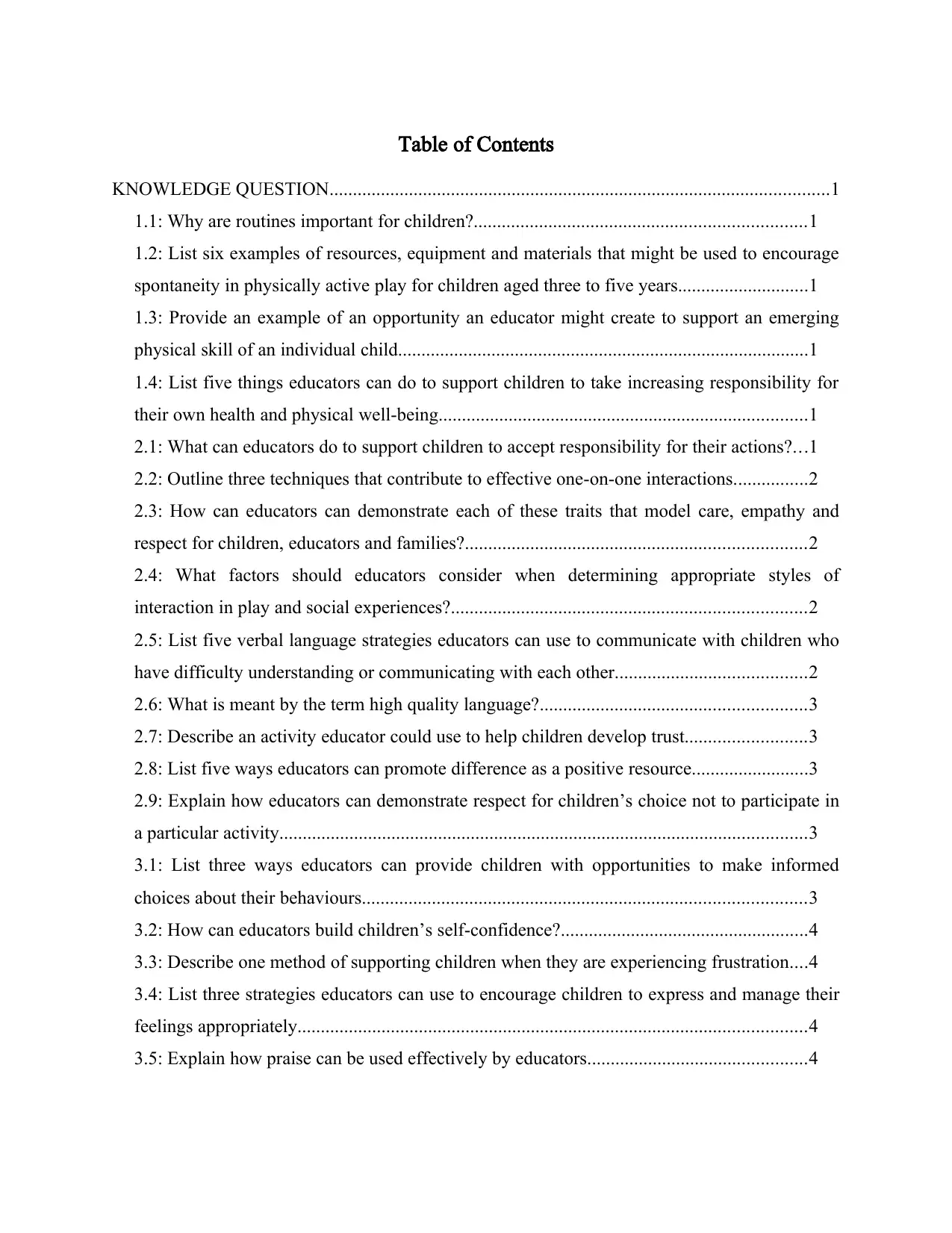
Table of Contents
KNOWLEDGE QUESTION...........................................................................................................1
1.1: Why are routines important for children?.......................................................................1
1.2: List six examples of resources, equipment and materials that might be used to encourage
spontaneity in physically active play for children aged three to five years............................1
1.3: Provide an example of an opportunity an educator might create to support an emerging
physical skill of an individual child........................................................................................1
1.4: List five things educators can do to support children to take increasing responsibility for
their own health and physical well-being...............................................................................1
2.1: What can educators do to support children to accept responsibility for their actions?...1
2.2: Outline three techniques that contribute to effective one-on-one interactions................2
2.3: How can educators can demonstrate each of these traits that model care, empathy and
respect for children, educators and families?.........................................................................2
2.4: What factors should educators consider when determining appropriate styles of
interaction in play and social experiences?............................................................................2
2.5: List five verbal language strategies educators can use to communicate with children who
have difficulty understanding or communicating with each other.........................................2
2.6: What is meant by the term high quality language?.........................................................3
2.7: Describe an activity educator could use to help children develop trust..........................3
2.8: List five ways educators can promote difference as a positive resource.........................3
2.9: Explain how educators can demonstrate respect for children’s choice not to participate in
a particular activity.................................................................................................................3
3.1: List three ways educators can provide children with opportunities to make informed
choices about their behaviours...............................................................................................3
3.2: How can educators build children’s self-confidence?.....................................................4
3.3: Describe one method of supporting children when they are experiencing frustration....4
3.4: List three strategies educators can use to encourage children to express and manage their
feelings appropriately.............................................................................................................4
3.5: Explain how praise can be used effectively by educators...............................................4
KNOWLEDGE QUESTION...........................................................................................................1
1.1: Why are routines important for children?.......................................................................1
1.2: List six examples of resources, equipment and materials that might be used to encourage
spontaneity in physically active play for children aged three to five years............................1
1.3: Provide an example of an opportunity an educator might create to support an emerging
physical skill of an individual child........................................................................................1
1.4: List five things educators can do to support children to take increasing responsibility for
their own health and physical well-being...............................................................................1
2.1: What can educators do to support children to accept responsibility for their actions?...1
2.2: Outline three techniques that contribute to effective one-on-one interactions................2
2.3: How can educators can demonstrate each of these traits that model care, empathy and
respect for children, educators and families?.........................................................................2
2.4: What factors should educators consider when determining appropriate styles of
interaction in play and social experiences?............................................................................2
2.5: List five verbal language strategies educators can use to communicate with children who
have difficulty understanding or communicating with each other.........................................2
2.6: What is meant by the term high quality language?.........................................................3
2.7: Describe an activity educator could use to help children develop trust..........................3
2.8: List five ways educators can promote difference as a positive resource.........................3
2.9: Explain how educators can demonstrate respect for children’s choice not to participate in
a particular activity.................................................................................................................3
3.1: List three ways educators can provide children with opportunities to make informed
choices about their behaviours...............................................................................................3
3.2: How can educators build children’s self-confidence?.....................................................4
3.3: Describe one method of supporting children when they are experiencing frustration....4
3.4: List three strategies educators can use to encourage children to express and manage their
feelings appropriately.............................................................................................................4
3.5: Explain how praise can be used effectively by educators...............................................4
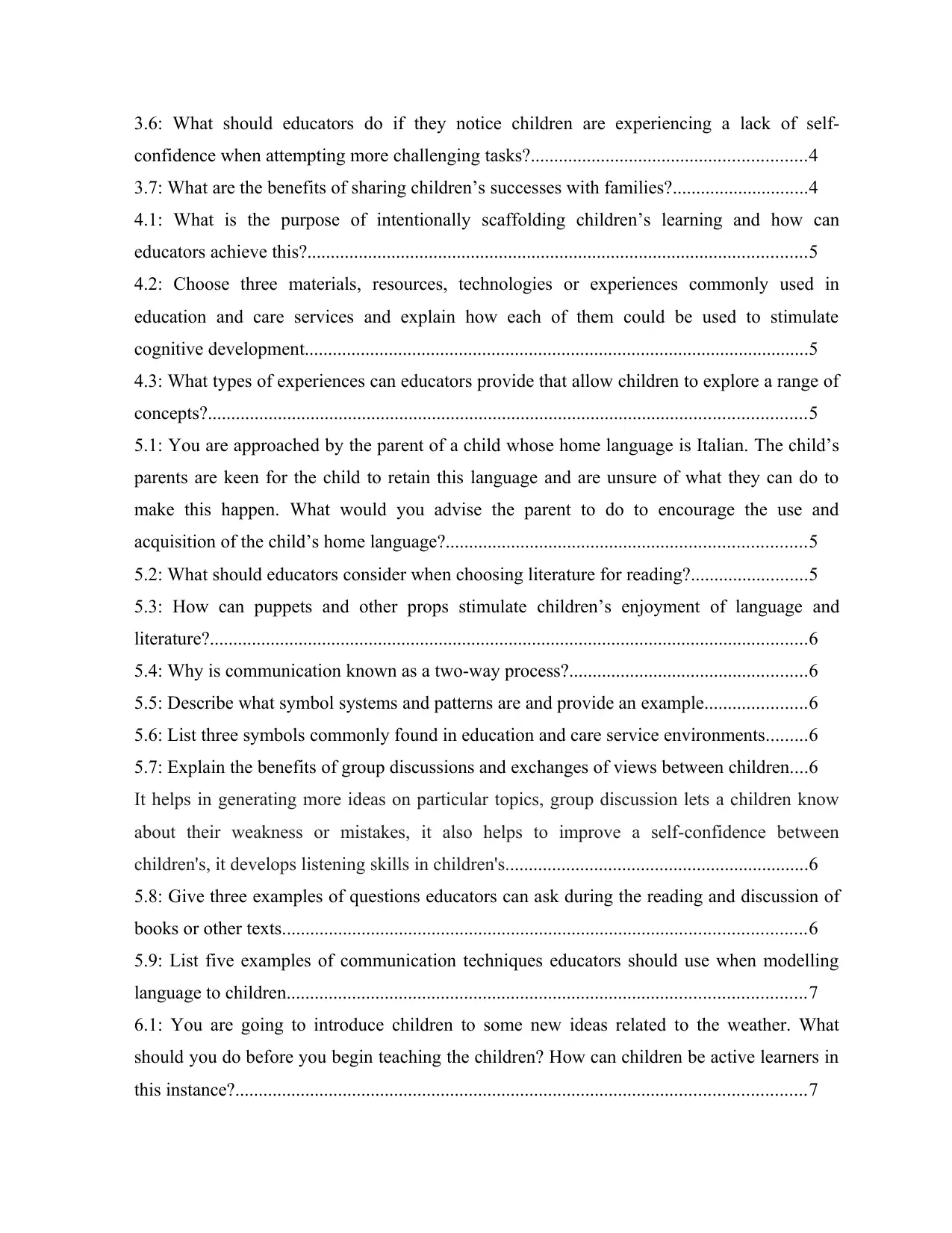
3.6: What should educators do if they notice children are experiencing a lack of self-
confidence when attempting more challenging tasks?...........................................................4
3.7: What are the benefits of sharing children’s successes with families?.............................4
4.1: What is the purpose of intentionally scaffolding children’s learning and how can
educators achieve this?...........................................................................................................5
4.2: Choose three materials, resources, technologies or experiences commonly used in
education and care services and explain how each of them could be used to stimulate
cognitive development............................................................................................................5
4.3: What types of experiences can educators provide that allow children to explore a range of
concepts?................................................................................................................................5
5.1: You are approached by the parent of a child whose home language is Italian. The child’s
parents are keen for the child to retain this language and are unsure of what they can do to
make this happen. What would you advise the parent to do to encourage the use and
acquisition of the child’s home language?.............................................................................5
5.2: What should educators consider when choosing literature for reading?.........................5
5.3: How can puppets and other props stimulate children’s enjoyment of language and
literature?................................................................................................................................6
5.4: Why is communication known as a two-way process?...................................................6
5.5: Describe what symbol systems and patterns are and provide an example......................6
5.6: List three symbols commonly found in education and care service environments.........6
5.7: Explain the benefits of group discussions and exchanges of views between children....6
It helps in generating more ideas on particular topics, group discussion lets a children know
about their weakness or mistakes, it also helps to improve a self-confidence between
children's, it develops listening skills in children's.................................................................6
5.8: Give three examples of questions educators can ask during the reading and discussion of
books or other texts................................................................................................................6
5.9: List five examples of communication techniques educators should use when modelling
language to children...............................................................................................................7
6.1: You are going to introduce children to some new ideas related to the weather. What
should you do before you begin teaching the children? How can children be active learners in
this instance?..........................................................................................................................7
confidence when attempting more challenging tasks?...........................................................4
3.7: What are the benefits of sharing children’s successes with families?.............................4
4.1: What is the purpose of intentionally scaffolding children’s learning and how can
educators achieve this?...........................................................................................................5
4.2: Choose three materials, resources, technologies or experiences commonly used in
education and care services and explain how each of them could be used to stimulate
cognitive development............................................................................................................5
4.3: What types of experiences can educators provide that allow children to explore a range of
concepts?................................................................................................................................5
5.1: You are approached by the parent of a child whose home language is Italian. The child’s
parents are keen for the child to retain this language and are unsure of what they can do to
make this happen. What would you advise the parent to do to encourage the use and
acquisition of the child’s home language?.............................................................................5
5.2: What should educators consider when choosing literature for reading?.........................5
5.3: How can puppets and other props stimulate children’s enjoyment of language and
literature?................................................................................................................................6
5.4: Why is communication known as a two-way process?...................................................6
5.5: Describe what symbol systems and patterns are and provide an example......................6
5.6: List three symbols commonly found in education and care service environments.........6
5.7: Explain the benefits of group discussions and exchanges of views between children....6
It helps in generating more ideas on particular topics, group discussion lets a children know
about their weakness or mistakes, it also helps to improve a self-confidence between
children's, it develops listening skills in children's.................................................................6
5.8: Give three examples of questions educators can ask during the reading and discussion of
books or other texts................................................................................................................6
5.9: List five examples of communication techniques educators should use when modelling
language to children...............................................................................................................7
6.1: You are going to introduce children to some new ideas related to the weather. What
should you do before you begin teaching the children? How can children be active learners in
this instance?..........................................................................................................................7
⊘ This is a preview!⊘
Do you want full access?
Subscribe today to unlock all pages.

Trusted by 1+ million students worldwide

6.2: Identify five materials and resources that can be used to challenge, intrigue and surprise
children...................................................................................................................................7
6.3: Describe three things that you could do to help children feel that they belong and are
connected to the childhood education and care service..........................................................7
6.4: Engaging children in sustained shared conversations helps to extend their thinking.
Provide six examples of how educators can incorporate this into play..................................7
6.5: What is meant by the term scaffolding learning and development?...............................8
6.6: A child is learning to say the alphabet. When they get to letter l they
say n, m, l, o, p instead of l, m, n, o, how can you correct their mistake and help them to see it
as an opportunity to learn and grow?.....................................................................................8
6.7: Identify five ways that families from diverse backgrounds might be able to contribute to
the learning environment........................................................................................................8
6.8: A parent tells you that their family are all vegetarians. The child is expected to follow a
vegetarian diet. Should this information be shared with colleagues?....................................8
7.1: Conduct independent research on a code of ethics relevant to a child care setting and
provide an overview of the intent and content of the code.....................................................9
7.2: Conduct independent research on the United Nations Convention on the Rights of the
Child, provide an overview of the Convention and describe how it relates to education and
care services............................................................................................................................9
7.3: Where can you access copies of the National Quality Framework (NQF), National
Quality Standards (NQS) and the Early Years Learning Framework (EYLF)? Where can more
advice, support and information about the NQS, NQF and EYLF be found? When navigating
the EYLF what are the five outcomes that you will find information about?........................9
7.4: Navigate through one of the NQF, The Early Years Learning Framework, or the National
Quality Standard and find two areas relevant to supporting the holistic development of
children in early childhood. Provide an overview of each of the areas you find...................9
7.5: Conduct independent research on each of these topics about child development and
provide a half page summary of your findings for each topic..............................................10
7.6: List five factors that can contribute to poor early childhood development...................10
7.7: Which of these influences on child development are biological and which are
environmental.?....................................................................................................................10
children...................................................................................................................................7
6.3: Describe three things that you could do to help children feel that they belong and are
connected to the childhood education and care service..........................................................7
6.4: Engaging children in sustained shared conversations helps to extend their thinking.
Provide six examples of how educators can incorporate this into play..................................7
6.5: What is meant by the term scaffolding learning and development?...............................8
6.6: A child is learning to say the alphabet. When they get to letter l they
say n, m, l, o, p instead of l, m, n, o, how can you correct their mistake and help them to see it
as an opportunity to learn and grow?.....................................................................................8
6.7: Identify five ways that families from diverse backgrounds might be able to contribute to
the learning environment........................................................................................................8
6.8: A parent tells you that their family are all vegetarians. The child is expected to follow a
vegetarian diet. Should this information be shared with colleagues?....................................8
7.1: Conduct independent research on a code of ethics relevant to a child care setting and
provide an overview of the intent and content of the code.....................................................9
7.2: Conduct independent research on the United Nations Convention on the Rights of the
Child, provide an overview of the Convention and describe how it relates to education and
care services............................................................................................................................9
7.3: Where can you access copies of the National Quality Framework (NQF), National
Quality Standards (NQS) and the Early Years Learning Framework (EYLF)? Where can more
advice, support and information about the NQS, NQF and EYLF be found? When navigating
the EYLF what are the five outcomes that you will find information about?........................9
7.4: Navigate through one of the NQF, The Early Years Learning Framework, or the National
Quality Standard and find two areas relevant to supporting the holistic development of
children in early childhood. Provide an overview of each of the areas you find...................9
7.5: Conduct independent research on each of these topics about child development and
provide a half page summary of your findings for each topic..............................................10
7.6: List five factors that can contribute to poor early childhood development...................10
7.7: Which of these influences on child development are biological and which are
environmental.?....................................................................................................................10
Paraphrase This Document
Need a fresh take? Get an instant paraphrase of this document with our AI Paraphraser

PERFORMANCE TASK..............................................................................................................11
TASK 1..........................................................................................................................................11
Support the physical development of children and plan activities in at least three different
situations or activities by:.....................................................................................................11
TASK 2..........................................................................................................................................12
Support the social development of children and plan activities in at least three different
situations or activities by:.....................................................................................................12
TASK 3..........................................................................................................................................13
Support the emotional development of children in at least three different situations or
activities by:..........................................................................................................................13
TASK 4..........................................................................................................................................13
Support the cognitive development of children and plan activities in at least three different
situations or activities by:.....................................................................................................13
TASK 5..........................................................................................................................................14
Support the communication development of children and plan activities in at least
three different situations or activities by:.............................................................................14
TASK 6..........................................................................................................................................14
Create an environment for holistic learning and development in at least three different
situations or activities by:.....................................................................................................14
TASK 1..........................................................................................................................................11
Support the physical development of children and plan activities in at least three different
situations or activities by:.....................................................................................................11
TASK 2..........................................................................................................................................12
Support the social development of children and plan activities in at least three different
situations or activities by:.....................................................................................................12
TASK 3..........................................................................................................................................13
Support the emotional development of children in at least three different situations or
activities by:..........................................................................................................................13
TASK 4..........................................................................................................................................13
Support the cognitive development of children and plan activities in at least three different
situations or activities by:.....................................................................................................13
TASK 5..........................................................................................................................................14
Support the communication development of children and plan activities in at least
three different situations or activities by:.............................................................................14
TASK 6..........................................................................................................................................14
Create an environment for holistic learning and development in at least three different
situations or activities by:.....................................................................................................14
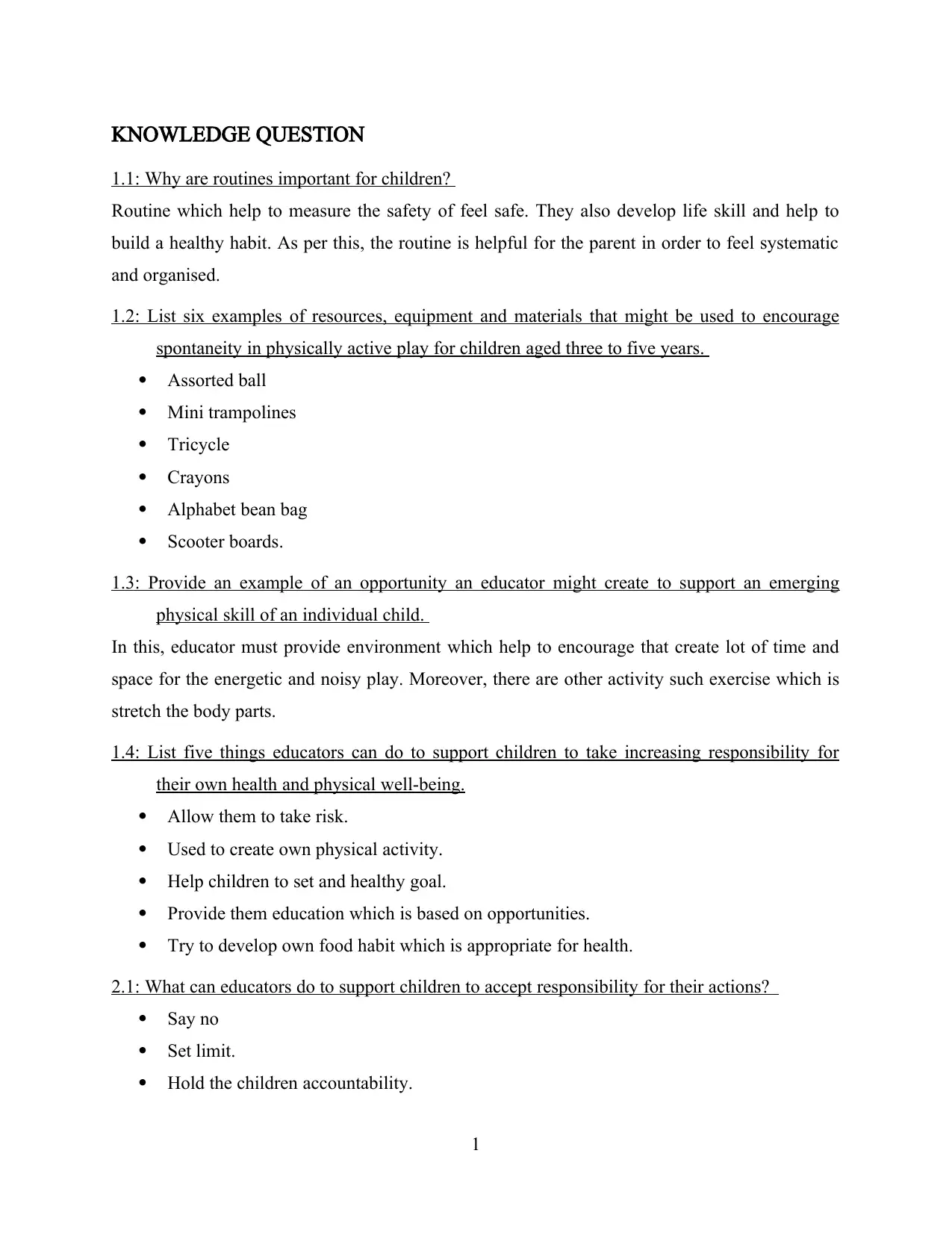
KNOWLEDGE QUESTION
1.1: Why are routines important for children?
Routine which help to measure the safety of feel safe. They also develop life skill and help to
build a healthy habit. As per this, the routine is helpful for the parent in order to feel systematic
and organised.
1.2: List six examples of resources, equipment and materials that might be used to encourage
spontaneity in physically active play for children aged three to five years.
Assorted ball
Mini trampolines
Tricycle
Crayons
Alphabet bean bag
Scooter boards.
1.3: Provide an example of an opportunity an educator might create to support an emerging
physical skill of an individual child.
In this, educator must provide environment which help to encourage that create lot of time and
space for the energetic and noisy play. Moreover, there are other activity such exercise which is
stretch the body parts.
1.4: List five things educators can do to support children to take increasing responsibility for
their own health and physical well-being.
Allow them to take risk.
Used to create own physical activity.
Help children to set and healthy goal.
Provide them education which is based on opportunities.
Try to develop own food habit which is appropriate for health.
2.1: What can educators do to support children to accept responsibility for their actions?
Say no
Set limit.
Hold the children accountability.
1
1.1: Why are routines important for children?
Routine which help to measure the safety of feel safe. They also develop life skill and help to
build a healthy habit. As per this, the routine is helpful for the parent in order to feel systematic
and organised.
1.2: List six examples of resources, equipment and materials that might be used to encourage
spontaneity in physically active play for children aged three to five years.
Assorted ball
Mini trampolines
Tricycle
Crayons
Alphabet bean bag
Scooter boards.
1.3: Provide an example of an opportunity an educator might create to support an emerging
physical skill of an individual child.
In this, educator must provide environment which help to encourage that create lot of time and
space for the energetic and noisy play. Moreover, there are other activity such exercise which is
stretch the body parts.
1.4: List five things educators can do to support children to take increasing responsibility for
their own health and physical well-being.
Allow them to take risk.
Used to create own physical activity.
Help children to set and healthy goal.
Provide them education which is based on opportunities.
Try to develop own food habit which is appropriate for health.
2.1: What can educators do to support children to accept responsibility for their actions?
Say no
Set limit.
Hold the children accountability.
1
⊘ This is a preview!⊘
Do you want full access?
Subscribe today to unlock all pages.

Trusted by 1+ million students worldwide
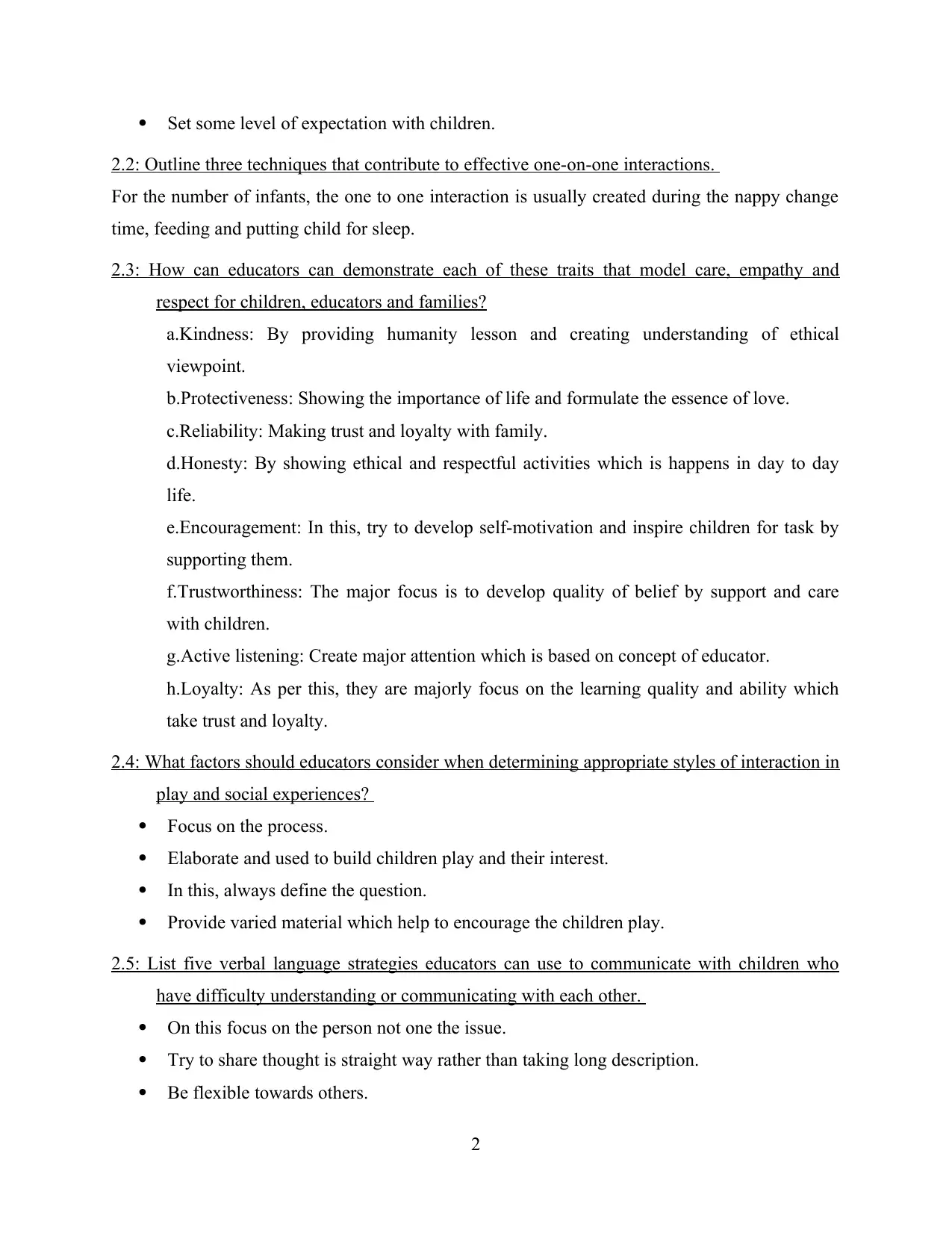
Set some level of expectation with children.
2.2: Outline three techniques that contribute to effective one-on-one interactions.
For the number of infants, the one to one interaction is usually created during the nappy change
time, feeding and putting child for sleep.
2.3: How can educators can demonstrate each of these traits that model care, empathy and
respect for children, educators and families?
a.Kindness: By providing humanity lesson and creating understanding of ethical
viewpoint.
b.Protectiveness: Showing the importance of life and formulate the essence of love.
c.Reliability: Making trust and loyalty with family.
d.Honesty: By showing ethical and respectful activities which is happens in day to day
life.
e.Encouragement: In this, try to develop self-motivation and inspire children for task by
supporting them.
f.Trustworthiness: The major focus is to develop quality of belief by support and care
with children.
g.Active listening: Create major attention which is based on concept of educator.
h.Loyalty: As per this, they are majorly focus on the learning quality and ability which
take trust and loyalty.
2.4: What factors should educators consider when determining appropriate styles of interaction in
play and social experiences?
Focus on the process.
Elaborate and used to build children play and their interest.
In this, always define the question.
Provide varied material which help to encourage the children play.
2.5: List five verbal language strategies educators can use to communicate with children who
have difficulty understanding or communicating with each other.
On this focus on the person not one the issue.
Try to share thought is straight way rather than taking long description.
Be flexible towards others.
2
2.2: Outline three techniques that contribute to effective one-on-one interactions.
For the number of infants, the one to one interaction is usually created during the nappy change
time, feeding and putting child for sleep.
2.3: How can educators can demonstrate each of these traits that model care, empathy and
respect for children, educators and families?
a.Kindness: By providing humanity lesson and creating understanding of ethical
viewpoint.
b.Protectiveness: Showing the importance of life and formulate the essence of love.
c.Reliability: Making trust and loyalty with family.
d.Honesty: By showing ethical and respectful activities which is happens in day to day
life.
e.Encouragement: In this, try to develop self-motivation and inspire children for task by
supporting them.
f.Trustworthiness: The major focus is to develop quality of belief by support and care
with children.
g.Active listening: Create major attention which is based on concept of educator.
h.Loyalty: As per this, they are majorly focus on the learning quality and ability which
take trust and loyalty.
2.4: What factors should educators consider when determining appropriate styles of interaction in
play and social experiences?
Focus on the process.
Elaborate and used to build children play and their interest.
In this, always define the question.
Provide varied material which help to encourage the children play.
2.5: List five verbal language strategies educators can use to communicate with children who
have difficulty understanding or communicating with each other.
On this focus on the person not one the issue.
Try to share thought is straight way rather than taking long description.
Be flexible towards others.
2
Paraphrase This Document
Need a fresh take? Get an instant paraphrase of this document with our AI Paraphraser

Use affirming responses.
Value and in own experience.
2.6: What is meant by the term high quality language?
In this, the high quality language which help to formulate children development on the basis of
vocabulary and boost the communication skill and learning skills.
2.7: Describe an activity educator could use to help children develop trust.
Try to such activities which is develop pairing and team and this teamwork help to develop trust
while get through the obstacle with safer way.
2.8: List five ways educators can promote difference as a positive resource.
In this, they are ensuring about the child attention.
Use words which is proper to the child development. Be clear and simple.
Provide children with some of the respect with same age of children and with adults.
Try to rephrase words and sentence which is not understand with that words.
Be aware of body language which is based on the speaking which have number of body
language that is meaningful to children.
2.9: Explain how educators can demonstrate respect for children’s choice not to participate in a
particular activity.
Allow children to make their own choices about which is based on body.
Use good manner when interacting with children.
Respond from the forcing with child.
Respond with any issue with a proper grace.
3.1: List three ways educators can provide children with opportunities to make informed choices
about their behaviours.
It is essential for people to understand this process as it helps to empower children to make
confident decisions regarding their well-being. The opportunities which should be provided to
children involves participation of children in everyday decisions, giving a chance to make
choices, ask children to set their goals.
3
Value and in own experience.
2.6: What is meant by the term high quality language?
In this, the high quality language which help to formulate children development on the basis of
vocabulary and boost the communication skill and learning skills.
2.7: Describe an activity educator could use to help children develop trust.
Try to such activities which is develop pairing and team and this teamwork help to develop trust
while get through the obstacle with safer way.
2.8: List five ways educators can promote difference as a positive resource.
In this, they are ensuring about the child attention.
Use words which is proper to the child development. Be clear and simple.
Provide children with some of the respect with same age of children and with adults.
Try to rephrase words and sentence which is not understand with that words.
Be aware of body language which is based on the speaking which have number of body
language that is meaningful to children.
2.9: Explain how educators can demonstrate respect for children’s choice not to participate in a
particular activity.
Allow children to make their own choices about which is based on body.
Use good manner when interacting with children.
Respond from the forcing with child.
Respond with any issue with a proper grace.
3.1: List three ways educators can provide children with opportunities to make informed choices
about their behaviours.
It is essential for people to understand this process as it helps to empower children to make
confident decisions regarding their well-being. The opportunities which should be provided to
children involves participation of children in everyday decisions, giving a chance to make
choices, ask children to set their goals.
3

3.2: How can educators build children’s self-confidence?
Children's self-confidence can be built by various ways such as teaching various skills so that
children feel that they can do things, praise their efforts not just their success, listen to them and
accept their feelings.
3.3: Describe one method of supporting children when they are experiencing frustration
In order to overcome children's frustration, people try not to copy that frustration in their own
voice. People should admit child's frustration or anger and naming their feelings can help a child
to look at words to explain their emotions.
3.4: List three strategies educators can use to encourage children to express and manage their
feelings appropriately.
The strategies which an educator can use includes teaching about how feelings can be expressed,
offering a deep nurturing connections, giving a plan to handle situations or problems. These can
help to support children to manage their feelings.
3.5: Explain how praise can be used effectively by educators.
Keep praising children as it is one of the most powerful tool to occupy as well as motivate them.
When it is used effectively, it can develop a child's behaviour or attitude in order to explore more
things.
3.6: What should educators do if they notice children are experiencing a lack of self-confidence
when attempting more challenging tasks?
There are some strategies which enhance the self-confidence of children when experiencing
more challenging tasks such as identification of the situations which make trouble, accept the
challenges in a positive way, awareness about beliefs and thoughts.
3.7: What are the benefits of sharing children’s successes with families?
By sharing children's success with their families gives a positive feedback to them and creates a
positive surrounding around them. The benefit from this type of environment can helps a child to
encourage their mental health as well as wellness.
4
Children's self-confidence can be built by various ways such as teaching various skills so that
children feel that they can do things, praise their efforts not just their success, listen to them and
accept their feelings.
3.3: Describe one method of supporting children when they are experiencing frustration
In order to overcome children's frustration, people try not to copy that frustration in their own
voice. People should admit child's frustration or anger and naming their feelings can help a child
to look at words to explain their emotions.
3.4: List three strategies educators can use to encourage children to express and manage their
feelings appropriately.
The strategies which an educator can use includes teaching about how feelings can be expressed,
offering a deep nurturing connections, giving a plan to handle situations or problems. These can
help to support children to manage their feelings.
3.5: Explain how praise can be used effectively by educators.
Keep praising children as it is one of the most powerful tool to occupy as well as motivate them.
When it is used effectively, it can develop a child's behaviour or attitude in order to explore more
things.
3.6: What should educators do if they notice children are experiencing a lack of self-confidence
when attempting more challenging tasks?
There are some strategies which enhance the self-confidence of children when experiencing
more challenging tasks such as identification of the situations which make trouble, accept the
challenges in a positive way, awareness about beliefs and thoughts.
3.7: What are the benefits of sharing children’s successes with families?
By sharing children's success with their families gives a positive feedback to them and creates a
positive surrounding around them. The benefit from this type of environment can helps a child to
encourage their mental health as well as wellness.
4
⊘ This is a preview!⊘
Do you want full access?
Subscribe today to unlock all pages.

Trusted by 1+ million students worldwide
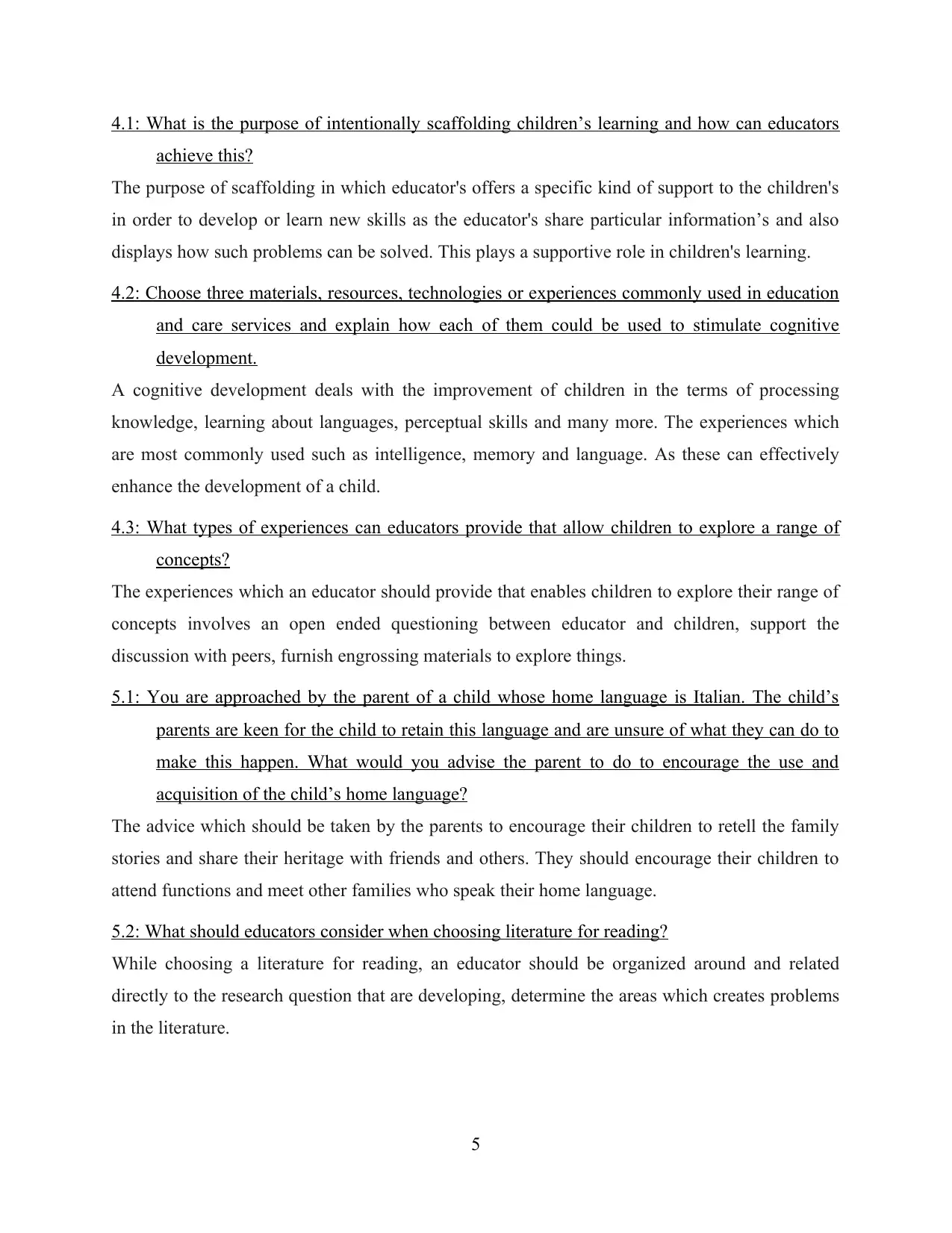
4.1: What is the purpose of intentionally scaffolding children’s learning and how can educators
achieve this?
The purpose of scaffolding in which educator's offers a specific kind of support to the children's
in order to develop or learn new skills as the educator's share particular information’s and also
displays how such problems can be solved. This plays a supportive role in children's learning.
4.2: Choose three materials, resources, technologies or experiences commonly used in education
and care services and explain how each of them could be used to stimulate cognitive
development.
A cognitive development deals with the improvement of children in the terms of processing
knowledge, learning about languages, perceptual skills and many more. The experiences which
are most commonly used such as intelligence, memory and language. As these can effectively
enhance the development of a child.
4.3: What types of experiences can educators provide that allow children to explore a range of
concepts?
The experiences which an educator should provide that enables children to explore their range of
concepts involves an open ended questioning between educator and children, support the
discussion with peers, furnish engrossing materials to explore things.
5.1: You are approached by the parent of a child whose home language is Italian. The child’s
parents are keen for the child to retain this language and are unsure of what they can do to
make this happen. What would you advise the parent to do to encourage the use and
acquisition of the child’s home language?
The advice which should be taken by the parents to encourage their children to retell the family
stories and share their heritage with friends and others. They should encourage their children to
attend functions and meet other families who speak their home language.
5.2: What should educators consider when choosing literature for reading?
While choosing a literature for reading, an educator should be organized around and related
directly to the research question that are developing, determine the areas which creates problems
in the literature.
5
achieve this?
The purpose of scaffolding in which educator's offers a specific kind of support to the children's
in order to develop or learn new skills as the educator's share particular information’s and also
displays how such problems can be solved. This plays a supportive role in children's learning.
4.2: Choose three materials, resources, technologies or experiences commonly used in education
and care services and explain how each of them could be used to stimulate cognitive
development.
A cognitive development deals with the improvement of children in the terms of processing
knowledge, learning about languages, perceptual skills and many more. The experiences which
are most commonly used such as intelligence, memory and language. As these can effectively
enhance the development of a child.
4.3: What types of experiences can educators provide that allow children to explore a range of
concepts?
The experiences which an educator should provide that enables children to explore their range of
concepts involves an open ended questioning between educator and children, support the
discussion with peers, furnish engrossing materials to explore things.
5.1: You are approached by the parent of a child whose home language is Italian. The child’s
parents are keen for the child to retain this language and are unsure of what they can do to
make this happen. What would you advise the parent to do to encourage the use and
acquisition of the child’s home language?
The advice which should be taken by the parents to encourage their children to retell the family
stories and share their heritage with friends and others. They should encourage their children to
attend functions and meet other families who speak their home language.
5.2: What should educators consider when choosing literature for reading?
While choosing a literature for reading, an educator should be organized around and related
directly to the research question that are developing, determine the areas which creates problems
in the literature.
5
Paraphrase This Document
Need a fresh take? Get an instant paraphrase of this document with our AI Paraphraser
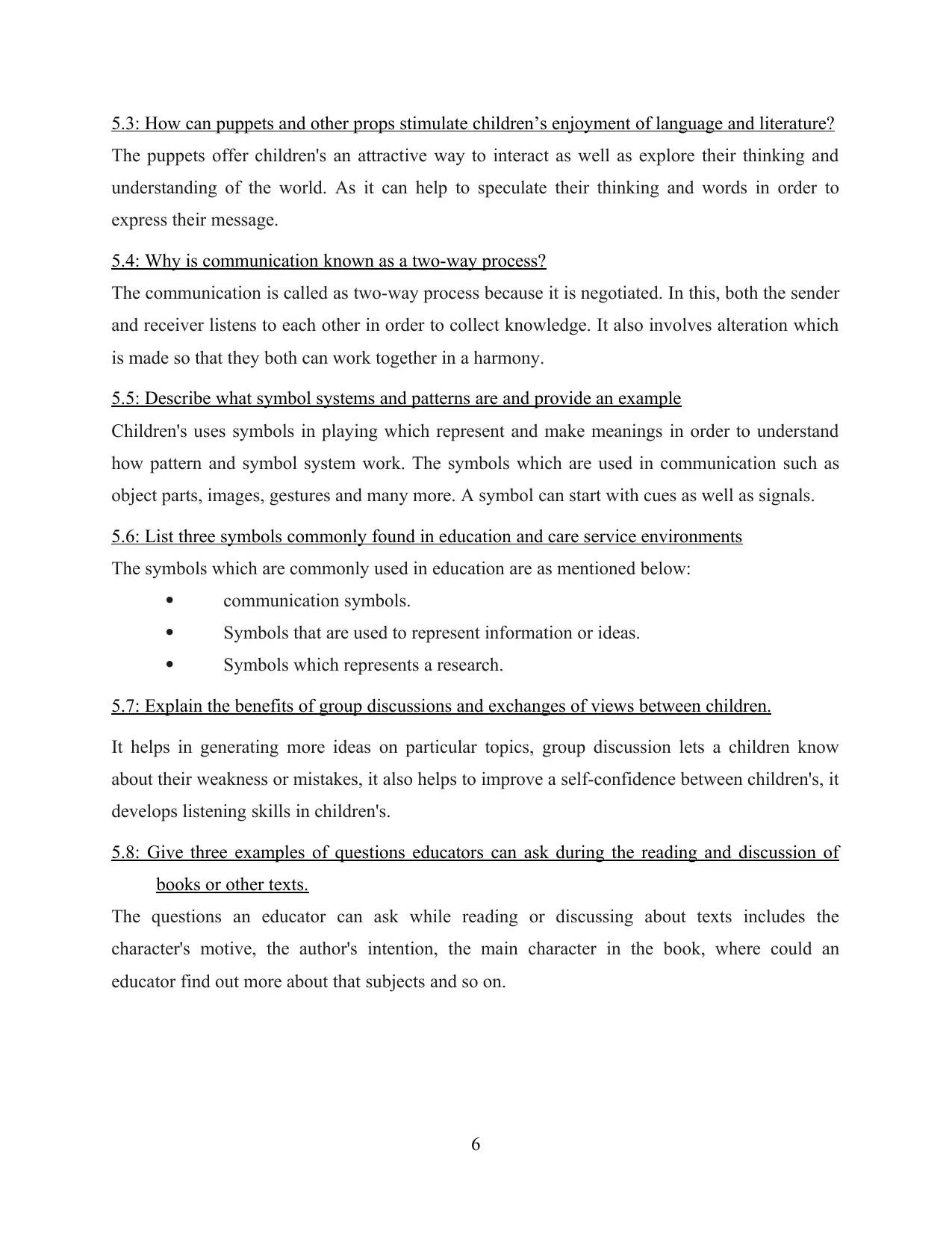
5.3: How can puppets and other props stimulate children’s enjoyment of language and literature?
The puppets offer children's an attractive way to interact as well as explore their thinking and
understanding of the world. As it can help to speculate their thinking and words in order to
express their message.
5.4: Why is communication known as a two-way process?
The communication is called as two-way process because it is negotiated. In this, both the sender
and receiver listens to each other in order to collect knowledge. It also involves alteration which
is made so that they both can work together in a harmony.
5.5: Describe what symbol systems and patterns are and provide an example
Children's uses symbols in playing which represent and make meanings in order to understand
how pattern and symbol system work. The symbols which are used in communication such as
object parts, images, gestures and many more. A symbol can start with cues as well as signals.
5.6: List three symbols commonly found in education and care service environments
The symbols which are commonly used in education are as mentioned below:
communication symbols.
Symbols that are used to represent information or ideas.
Symbols which represents a research.
5.7: Explain the benefits of group discussions and exchanges of views between children.
It helps in generating more ideas on particular topics, group discussion lets a children know
about their weakness or mistakes, it also helps to improve a self-confidence between children's, it
develops listening skills in children's.
5.8: Give three examples of questions educators can ask during the reading and discussion of
books or other texts.
The questions an educator can ask while reading or discussing about texts includes the
character's motive, the author's intention, the main character in the book, where could an
educator find out more about that subjects and so on.
6
The puppets offer children's an attractive way to interact as well as explore their thinking and
understanding of the world. As it can help to speculate their thinking and words in order to
express their message.
5.4: Why is communication known as a two-way process?
The communication is called as two-way process because it is negotiated. In this, both the sender
and receiver listens to each other in order to collect knowledge. It also involves alteration which
is made so that they both can work together in a harmony.
5.5: Describe what symbol systems and patterns are and provide an example
Children's uses symbols in playing which represent and make meanings in order to understand
how pattern and symbol system work. The symbols which are used in communication such as
object parts, images, gestures and many more. A symbol can start with cues as well as signals.
5.6: List three symbols commonly found in education and care service environments
The symbols which are commonly used in education are as mentioned below:
communication symbols.
Symbols that are used to represent information or ideas.
Symbols which represents a research.
5.7: Explain the benefits of group discussions and exchanges of views between children.
It helps in generating more ideas on particular topics, group discussion lets a children know
about their weakness or mistakes, it also helps to improve a self-confidence between children's, it
develops listening skills in children's.
5.8: Give three examples of questions educators can ask during the reading and discussion of
books or other texts.
The questions an educator can ask while reading or discussing about texts includes the
character's motive, the author's intention, the main character in the book, where could an
educator find out more about that subjects and so on.
6

5.9: List five examples of communication techniques educators should use when modelling
language to children.
The communication techniques which are used to develop language among children's involves
the reading of books as well as telling about stories plays a key role to encourage the language
and communication skills among children's. As reading books can promote skills like learning
different vocabulary words.
6.1: You are going to introduce children to some new ideas related to the weather. What should
you do before you begin teaching the children? How can children be active learners in this
instance?
In this, as an educator try to explain about the colour and beautiful segment of every weather and
their essence. Moreover, children take interest when the educator used to deliver this information
in form of storytelling.
6.2: Identify five materials and resources that can be used to challenge, intrigue and surprise
children
Puzzles.
New activities and game.
Arts and craft.
Produce and collage.
Small word play.
6.3: Describe three things that you could do to help children feel that they belong and are
connected to the childhood education and care service.
Start with morning which is best to show the best children that is value is first thing in
morning.
Invest time on their interest which is based on children which is based to encourage their
interest.
Prioritize their need and requirement.
6.4: Engaging children in sustained shared conversations helps to extend their thinking. Provide
six examples of how educators can incorporate this into play
Create play based learning centre.
7
language to children.
The communication techniques which are used to develop language among children's involves
the reading of books as well as telling about stories plays a key role to encourage the language
and communication skills among children's. As reading books can promote skills like learning
different vocabulary words.
6.1: You are going to introduce children to some new ideas related to the weather. What should
you do before you begin teaching the children? How can children be active learners in this
instance?
In this, as an educator try to explain about the colour and beautiful segment of every weather and
their essence. Moreover, children take interest when the educator used to deliver this information
in form of storytelling.
6.2: Identify five materials and resources that can be used to challenge, intrigue and surprise
children
Puzzles.
New activities and game.
Arts and craft.
Produce and collage.
Small word play.
6.3: Describe three things that you could do to help children feel that they belong and are
connected to the childhood education and care service.
Start with morning which is best to show the best children that is value is first thing in
morning.
Invest time on their interest which is based on children which is based to encourage their
interest.
Prioritize their need and requirement.
6.4: Engaging children in sustained shared conversations helps to extend their thinking. Provide
six examples of how educators can incorporate this into play
Create play based learning centre.
7
⊘ This is a preview!⊘
Do you want full access?
Subscribe today to unlock all pages.

Trusted by 1+ million students worldwide
1 out of 20
Related Documents
Your All-in-One AI-Powered Toolkit for Academic Success.
+13062052269
info@desklib.com
Available 24*7 on WhatsApp / Email
![[object Object]](/_next/static/media/star-bottom.7253800d.svg)
Unlock your academic potential
Copyright © 2020–2025 A2Z Services. All Rights Reserved. Developed and managed by ZUCOL.





